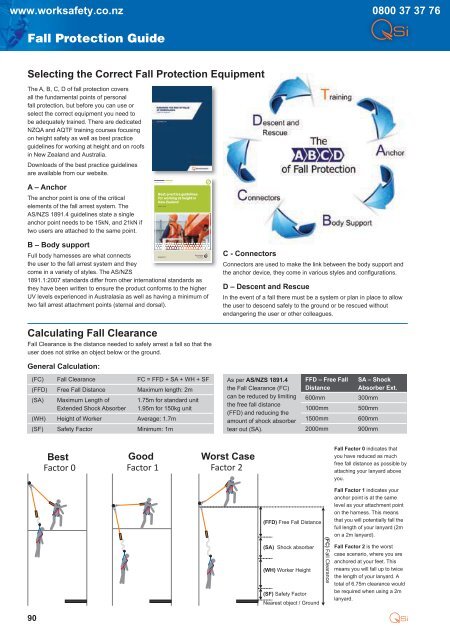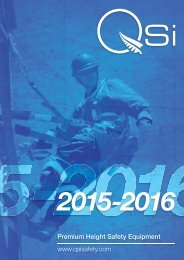Height Safety Catalogue 2018
Premium New Zealand Height Safety Equipment Catalogue for 2018
Premium New Zealand Height Safety Equipment Catalogue for 2018
You also want an ePaper? Increase the reach of your titles
YUMPU automatically turns print PDFs into web optimized ePapers that Google loves.
www.worksafety.co.nz 0800 37 37 76<br />
Fall Protection Guide<br />
Selecting the Correct Fall Protection Equipment<br />
The A, B, C, D of fall protection covers<br />
all the fundamental points of personal<br />
fall protection, but before you can use or<br />
select the correct equipment you need to<br />
be adequately trained. There are dedicated<br />
NZQA and AQTF training courses focusing<br />
on height safety as well as best practice<br />
guidelines for working at height and on roofs<br />
in New Zealand and Australia.<br />
Downloads of the best practice guidelines<br />
are available from our website.<br />
A – Anchor<br />
The anchor point is one of the critical<br />
elements of the fall arrest system. The<br />
AS/NZS 1891.4 guidelines state a single<br />
anchor point needs to be 15kN, and 21kN if<br />
two users are attached to the same point.<br />
Best practice guidelines<br />
for working at height in<br />
New Zealand<br />
APRIL 2012<br />
B – Body support<br />
Full body harnesses are what connects<br />
the user to the fall arrest system and they<br />
come in a variety of styles. The AS/NZS<br />
1891.1:2007 standards differ from other international standards as<br />
they have been written to ensure the product conforms to the higher<br />
UV levels experienced in Australasia as well as having a minimum of<br />
two fall arrest attachment points (sternal and dorsal).<br />
DOL 12048 APR 12<br />
C - Connectors<br />
Connectors are used to make the link between the body support and<br />
the anchor device, they come in various styles and conflgurations.<br />
D – Descent and Rescue<br />
In the event of a fall there must be a system or plan in place to allow<br />
the user to descend safely to the ground or be rescued without<br />
endangering the user or other colleagues.<br />
Calculating Fall Clearance<br />
Fall Clearance is the distance needed to safely arrest a fall so that the<br />
user does not strike an object below or the ground.<br />
General Calculation:<br />
(FC) Fall Clearance FC = FFD + SA + WH + SF<br />
(FFD) Free Fall Distance Maximum length: 2m<br />
(SA) Maximum Length of<br />
Extended Shock Absorber<br />
1.75m for standard unit<br />
1.95m for 150kg unit<br />
(WH) <strong>Height</strong> of Worker Average: 1.7m<br />
(SF) <strong>Safety</strong> Factor Minimum: 1m<br />
As per AS/NZS 1891.4<br />
the Fall Clearance (FC)<br />
can be reduced by limiting<br />
the free fall distance<br />
(FFD) and reducing the<br />
amount of shock absorber<br />
tear out (SA).<br />
FFD – Free Fall<br />
Distance<br />
600mm<br />
1000mm<br />
1500mm<br />
2000mm<br />
SA – Shock<br />
Absorber Ext.<br />
300mm<br />
500mm<br />
600mm<br />
900mm<br />
Fall Factor 0 indicates that<br />
you have reduced as much<br />
free fall distance as possible by<br />
attaching your lanyard above<br />
you.<br />
Fall Factor 1 indicates your<br />
anchor point is at the same<br />
level as your attachment point<br />
on the harness. This means<br />
that you will potentially fall the<br />
full length of your lanyard (2m<br />
on a 2m lanyard).<br />
Fall Factor 2 is the worst<br />
case scenario, where you are<br />
anchored at your feet. This<br />
means you will fall up to twice<br />
the length of your lanyard. A<br />
total of 6.75m clearance would<br />
be required when using a 2m<br />
lanyard.<br />
90




